Under changed climatic conditions, an expansion of irrigation on farms the Deccan plateau would negate any gains made in replenishing groundwater due to increased rainfall, new research on the rocky terrain of southern India shows. This could lead to further pressures on farms in a country that is already facing a crisis in agriculture.
Groundwater recharge happens when rain falls on the land surface, infiltrates into soil, and moves through pore spaces down to the water table.
Wells will increasingly dry up as more farms have increased irrigation in semi-arid areas, according to a study by scientists from India and the US recently published in the Science of the Total Environment journal. The changing climate may also lead to an increased frequency of extreme flow events such as flooding in the future, says the study “Future irrigation expansion outweigh groundwater recharge gains from climate change in semi-arid India”.
The scientists combined ground measurements with computer modelling to evaluate the effects of future climate from 2040 to 2069, with and without irrigation expansion, on water levels and flows in an agricultural watershed in low-storage crystalline aquifer region of south India. They used five global climate models that indicate that increased future rainfall (7-43%) with no further expansion of irrigation wells will increase groundwater recharge by 10-55%.
However, most of the recharged groundwater would move out of the watershed with increased base flow from 17% to 154%, the study found. This would result in only a small increase in net recharge of 0.2 mm per year.
Base flow is the flow of water entering stream channels from groundwater sources. A 100-year base flow event is “predicted to be a 5-year event in the future,” the study reports.
The study predicts that if irrigation expansion follows historical trends, “earlier and more frequent well drying, a source of farmers’ distress in India, will worsen in the future despite the recharge gains from increased rainfall”.
These findings clearly indicate the impacts of climate change in the hard rock region, which is the Deccan plateau region in central and southern India, said Suhas Wani, research programme director, Asia, at the Hyderabad-based International Crop Research Institute for Semi-Arid Tropics (ICRISAT), and one of the study authors.
Need for urgent action
This region will be “very much affected” because it has low storage capacity for groundwater, most of the aquifers are confined, and the main source of irrigation is from wells, which are replenished through base flows in the small watersheds, Wani told indiaclimatedialogue.net. “This clearly raises the flag for urgent action in terms of policies for managing the groundwater efficiently as well as also for ensuring the rainwater harvesting for recharging groundwater,” Wani said.
The study recommends converting at least a quarter of the irrigated area from the current flood irrigation technique, where farmers flow water down small trenches running through their crops, to drip irrigation, a planned irrigation system in which water is sent direct to plant roots via perforated pipes. It also recommends reducing energy subsidies such as free electricity from the current seven hours daily to 3.5 hours, among several other measures to achieve more sustainable food production in semi-arid regions.
Experts say the findings bring into question some of India’s policies on water and electricity use. “Populist measures adopted like free electricity, groundwater rights along with the land rights, and lack of punitive measures for inefficient use of water adopted currently are the points of concern for sustainable development of food systems as well as survival of the human beings in this region,” Wani said.
“One of the outcomes of our research is that there needs to be more focus on improving irrigation efficiency, reforming energy policy (subsidy), and improving water storage,” Sanjay Shukla, professor of water resources, agricultural and biological engineering department, University of Florida, and one of the study’s co-authors, told indiaclimatedialogue.net.
“Our results show worsened well drying and flooding in future. However, we think that the adverse impacts can be reduced with management and policy changes,” Shukla said. “In some states, current energy policy is worsening the water supply situation.”
Deccan plateau could suffer more
The research findings indicate that agriculture in the rocky Deccan plateau in southern India may suffer more due to the impacts of climate change than the plains of northern India. Northern India is endowed with deep, fertile soils that are rich in clay, and silt plains where much groundwater can be stored, while southern India has basalt rock, where groundwater storage is very much confined and limited, said Wani.
Groundwater recharge is also high in northern India because of better storage capacity, whereas in southern India, which has lower storage capacity, most of the recharge water ends up as base flow, he said.
Drying up of wells in southern India is high compared with northern India, Wani pointed out. Often farmers in southern India go on digging more wells in the same field, without any success, which is a cause for their distress.
The additional impacts of climate change, in terms of higher temperatures and increased transpiration is higher during the rainy and post-rainy seasons for crops in southern India compared with northern India, which has cool winters to offset, he added.
The implications of climate change for Indian agriculture “are very large and severe,” cautions Wani. “In some areas, the length of growing period is getting reduced drastically and with the change in the intensity of the rainfall, water demand during crop growing season will become a challenge,” he told indiaclimatedialogue.net.
Smallholders more vulnerable
“However, most of our landholdings are very small, around or less than a hectare, which makes small farm holders more vulnerable, as many of them do not have access to the needed finance, technologies and knowledge to cope with the impacts of climate change,” Wani said.
Also, most of India’s water management calculations are based on old hydrological datasets. “However, with the impacts of climate change, even if the rainfall quantity has not changed during the season as well as during the year, the frequency of heavy rainfall has increased, and occurrence of dry spells or drought during the crop growing period has also increased,” Wani said.
There is an urgent need to create more water storage capacity in each of the watersheds in order to meet the demands for supplemental or lifesaving irrigation during the dry spells, he added.
There is also an urgent need to understand the impacts of climate change at the micro and macro levels for better planning. This can only be done by involving all the stakeholders and ensuring that there are sufficient efforts for mitigating the impacts of the global warming through increased carbon sequestration through plantations, Wani said.
India needs to bridge the current yield gaps through improved management practices in the short term as adaption strategies’ and develop climate-resilient cultivars of various crops, which can withstand high temperatures and are drought-tolerant, without much loss in yield, he pointed out.
Better water management
One of India’s problems is that its agricultural research for dry lands assumes that enhancing irrigation will solve all the problems, Rajeswari Raina, agriculture policy expert and Professor at Shiv Nadar University, told indiaclimatedialogue.net. Water management, especially integrated water resources management, is the answer for dry land tracts, she said.
Several case studies show farmers and other water users in a watershed can effectively manage their water resources for crops and livestock by combining benefit-sharing mechanisms, conservation technologies and appropriate production technologies, Raina said. Here, irrigation is not offered as a technological solution, but as part of a more comprehensive package of processes and inputs.
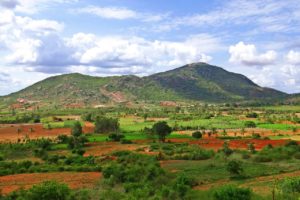
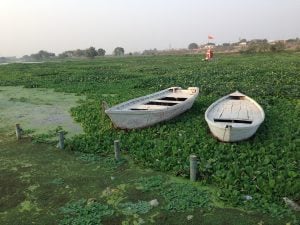

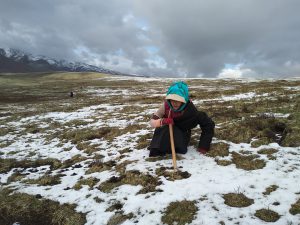

![Students of Presentation Convent School Peshawar look at stuffed wild species displayed during their visit to the Wildlife Department of Khyber Pakhtukhwa as part of awareness raising field tour [image by: Adeel Saeed]](https://dialogue.earth/content/uploads/2018/07/Students-at-wildlife-stall-in-abbottabad-300x200.jpg)
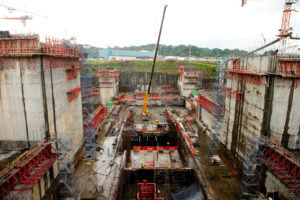
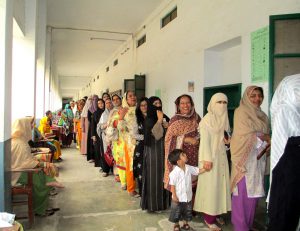
![Under Narendra Modi, there has been a renewed focus on building large dams and diverting rivers [Photo shows the Brahmaptura by: INDIA-ACTED-SAMISIVA-130]](https://dialogue.earth/content/uploads/2017/11/37440237726_e8fd1aa6d6_k-300x199.jpg)